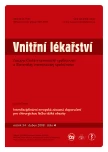The importance of determining the viability of the myocardium prior to revascularisation in patients with ischaemic cardiomyopathy and left ventricular systolic dysfunction
Authors:
M. Hutyra 1; T. Skála 1; M. Kamínek 2; D. Horák 3; J. Lukl 1
Authors‘ workplace:
I I. interní klinika Lékařské fakulty UP a FN Olomouc, přednosta prof. MUDr. Jan Lukl, CSc.
; Klinika nukleární medicíny Lékařské fakulty UP a FN Olomouc, přednosta doc. MUDr. Miroslav Mysliveček, Ph. D.
2; Radiologická klinika Lékařské fakulty UP a FN Olomouc, přednosta prof. MUDr. Miroslav Heřman, Ph. D.
3
Published in:
Vnitř Lék 2008; 54(4): 395-401
Category:
Review
Overview
Chronic heart failure is a worldwide clinical syndrome with substantial socio-economical impact. The aim of this overview is the summary of contemporary knowledge in epidemiology, elementary pathophysiological implications and some possibilities of treatment of ischemic cardiomyopathy, which represents the most frequent cause of heart failure in developed countries. Emphasis is on the right indication for myocardial revascularization as a causal option of therapy of ischemic cardiomyopathy, timing and risk of revascularization and especially on importance of assessment of viability of myocardium using presently available imaging methods.
Key words:
chronic heart failure - ischemic cardiomyopathy - myocardial viability - myocardial revascularization - stress echocardiography - cardiac magnetic resonance imaging - myocardial SPECT
Sources
1. American Heart Association. Heart and Stroke Statistics: 2004 Update. Dallas, Texas: American Heart Association 2003. <http://www.americanheart.org.>
2. Widimský J et al. Srdeční selhání. 2. ed. Praha: Triton 2004: 23-28.
3. Lloyd-Jones DM. Lifetime risk for developing congestive heart failure: the Framingham Heart Study. Circulation 2002; 106: 3068-3072.
4. Velazquez EJ. Acute heart failure complicating acute coronary syndromes: a deadly intersection. Circulation 2004; 109: 440-442.
5. Gheorghiade M. Chronic heart failure in the United States: a manifestation of coronary artery disease. Circulation 1998; 97: 282-289.
6. Gheorghiade M et al. Navigating the Crossroads of Coronary Artery Disease and Heart Failure. Circulation 2006; 114: 1202-1213.
7. Salomon SD, Anavekar N, Skali H et al. Influence of Ejection Fraction on Cardiovascular Outcomes in a Broad Spectrum of Heart Failure Patients. Circulation 2005; 112: 3738-3744.
8. Sheppard N et al. The histology of viable and hibernating myocardium in relation to imaging characteristics. J Am Coll Cardiol 2002; 39: 428-435.
9. Chareonthaitawee P. Revascularization in Severe Left Ventricular Dysfunction: The Role of Viability Testing. JACC 2005; 46: 567-574.
10. Roques F, Michel P, Goldstone AR et al. The logistic EuroSCORE. Eur Heart J 2003; 24: 882-883.
11. Topkara M et al. Coronary Artery Bypass Grafting in Patients With Low Ejection Fraction. Circulation 2005; 112: 344-350.
12. Alderman E, Fisher LD, Litwin P et al. Results of coronary artery surgery in patients with poor left ventricular dysfunction (CASS). Circulation 1983; 68: 785-795.
13. Allman KC, Shaw LJ, Hachamovitch F et al. Myocardial viability testing and impact of revascularization on prognosis in patients with coronary artery disease and left ventricular systolic dysfunction: a meta-analysis. J Am Coll Cardiol 2002; 39: 1151-1158.
14. Sedlis SP, Ramanathan KB, Morrison DA et al. Outcome of percutaneous coronary intervention versus coronary bypass grafting for patients with low left ventricular ejection fractions, unstable angina pectoris, and risk factors for adverse outcome with bypass (the AWESOME randomized trial and registry). Am J Cardiol 2004; 94: 118-120.
15. Bax JJ, van der Wall EE, Harbinson M. Radionuclide techniques for the assessment of myocardial viability and hibernation. Heart 2004; 90(Suppl 5): 26-33.
16. Eagle KA, Guyton RA, Davidoff R et al. ACC/AHA 2004 guidelines update for coronary artery bypass graft surgery: a report of the American College of Cardiology/American Heart Association Task Force on Practice Guidelines (Committee to Update the 1999 Guidelines for CABG Surgery). <http://www.acc.org/clinical/guidelines/cabg/cabg.pdf.>
17. Bax JJ, Poldermans D, Elhendy A et al. Sensitivity, specificity, and predictive accuracies of various noninvasive techniques for detecting hibernating myocardium. Curr Probl Cardiol 2001; 26: 141-186.
18. Meluzín J, Toman J. Ultrasonic tissue characterization in cardiology. Vnitř Lék 1998; 44: 487-490.
19. Baker DW, Jones R, Hodges J et al. Management of heart failure: The role of revascularization in the treatment of patients with moderate or severe left ventricular systolic dysfunction. JAMA 1994; 272: 1528-1534.
20. Di Sciascio G, Patti G, D’Ambrosio A et al. Coronary stenting in patients with depressed left ventricular function: acute and long-term results in a selected population. Catheter Cardiovasc Interv 2003; 59: 429-433.
Labels
Diabetology Endocrinology Internal medicineArticle was published in
Internal Medicine

2008 Issue 4
Most read in this issue
- Pericardiocentesis after cardiac surgery – our experience
- Lyme carditis – rare cause of dilated cardiomyopathy and rhythm disturbances
- ECG changes in alcoholic intoxication
- Human leukocyte differentiation antigens and CD classification
